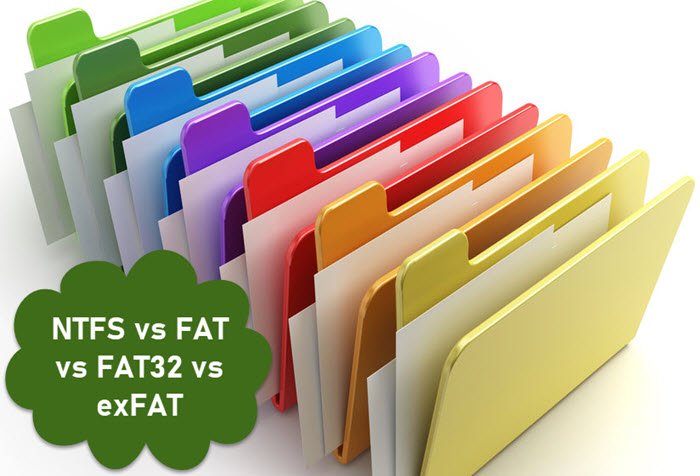Terms like NTFS and FAT file systems may appear synonymous to some. This is because many of us are not aware of the precise definition of these terms. In this post, we’ll attempt to answer a few of these questions like – What are FAT, FAT32, exFAT and NTFS file systems, and what are the difference between them.
NTFS vs FAT vs FAT32 vs exFAT

Both NTFS and FAT file systems are used in an operating system, but NTFS supports large file and volume size and provides efficient data organization in comparison to the other file systems.
What are FAT, FAT32, exFAT & NTFS file systems
NTFS and FAT are a file system that represents a technique of organizing and storing the data on the drive. These file systems also specify what type of attributes can be attached to a file such as filenames, permission, other attributes.
FAT file system
The acronym FAT stands for File Allocation Table. It is a simple file system designed originally for small disks and simple folder structures. In short, it is a method of organization, a file allocation table, which resides at the beginning of the volume. In the event of misfortune, two copies of the table are kept to protect the volume.
FAT32 is the de-facto standard. However, there’s a limitation of this standard. Individual files on a FAT32 drive cannot exceed 4 GB size limit. Also, FAT32 partition must be less than 8 TB. This is the reason why FAT32 is considered suitable for USB flash drives or external media but not for an internal drive.
exFAT file system
As the name suggests, exFAT is the abbreviation for ‘Extended File Allocation Table‘. It is an upgraded version of FAT32 created by Microsoft. It is similar to the FAT32 files system but does not have the limits of the FAT32 file system, i.e.; it allows users to store files much larger than the 4 GB allowed by FAT32.
NTFS file system
NTFS was mainly created with the intent of removing the limitations of the FAT file systems. Also, enable robust security. As such, the NTFS file system prevents unauthorized access to file contents by enforcing an encryption system named Encryption File System which uses public-key security.
Apart from the above, the FAT file system cannot open files with file names using non-English letters. This limitation is removed by NTFS. It can use any UTF characters. As such, it can easily be named using even difficult languages like Hindi, Korean, or Cyrillic.
Read: Quick Format vs Full Format explained.
Difference between NTFS, FAT, FAT32 & exFAT file systems
The FAT system, at the most supports, files up to 4GB in size. NTFS can have files up to 16 TB. NTFS is faster, allows extended file names, foreign characters & offers increased security with file encryption. FAT is Not compatible with the recent version of Windows & lacks security features found in the more modern NTFS file system. The other differences are:
NTFS
- Support for Drives over 40GB to 2TB Files over GB.
- Allows extended file names, foreign characters.
- Has a severely crippled maintenance system in chkdsk.
- Chkdsk is notoriously slow.
- Increased security with file encryption
- Faster on drives less than 40GB.
- Smaller file clusters, 4kb.
- Compression to reduce disk space.
- User permissions for files and folder.
- File copies are “undone” if the interrupted cluster is cleaned.
- Small files are kept in the Master file Table at the beginning of the drive.
FAT
- Not compatible with the recent version of Windows
- Support for Drive over 32MB to 2TB
- Features better more and interactive recovery utilities
- Check Disk operation is quick
- Just space for the OS to read files
- Faster on drives less than 10GB (FAT 16 cluster size is 32kb)
- Cluster chains containing data from interrupted copies are marked as damaged
- Master File table is separate from files.
FAT 32
- Lacks security features found in the more modern NTFS file system.
- Fails to install modern versions of Windows (Since the file is large in size and can be installed to drives formatted with NTFS).
exFAT
- exFAT drives can be accessed on Linux by installing the appropriate software.
- Works with all versions of Windows and modern versions of Mac OS X.
I hope this clarifies the matter.
UPDATE: Microsoft is removing the 32GB size limit for FAT32 partitions from the format command line in Windows 11. Although FAT supports volumes up to 2TB, Windows has a 32GB limit in place.
Quick read: How to change Hard Disk Cluster Size.
Leave a Reply